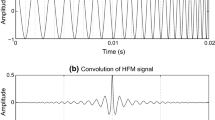Abstract
Reliable transmission and high data rate over underwater acoustic channels are considerably challenging. In this paper, we propose Multiple-Input and Multiple-Output (MIMO) scheme using a Hyperbolic Frequency Modulation (HFM) waveform. Our proposed system combines the advantages of both systems-special multiplexing of MIMO and immunity against Doppler shift of HFM. To increase the spectral efficiency, we employ M-ray HFM and overlapped sub-channels by leveraging the high temporal resolution characteristic. To verify effectiveness of our system, we have designed a theoretically enhanced acoustic simulator, which especially focuses on the reflection phenomenon by utilizing approved reflection loss models. Based on our acoustic simulator, we could verify that our system is robust against for multipath fading and Doppler shifting while keeping the multiplexing benefit of MIMO, while maintaining a very low complexity and system overhead. In addition, the results provide a useful insight for physical layer design in acoustic communication systems.















Similar content being viewed by others
References
Akyildiz, I. F., Pompili, D., & Melodia, T. (2005). Underwater acoustic sensor networks: Research challenges. Ad Hoc Networks, 3, 257–279.
Stojanovic, M., & Freitag, L. (2013). Recent trends in underwater acoustic communications. Marine Technology Society Journal, 47(5), 45–50.
Jiang, Z. (2008). Underwater acoustic networksissues and solutions. International Journal of Intelligent Control and Systems, 13(3), 152–161.
Stojanovic, M., & Preisig, J. (2009). Underwater acoustic communication channels: Propagation models and statistical. Communications Magazine, 47(1), 84–89.
Yang, W. B., & Yang, T. C. (2006). M-ary frequency shift keying communications over an underwater acoustic channel: Performance comparison of data with models. The Journal of the Acoustical Society of America, 120(5), 2694–2701.
Singer, A. C., Nelson, J. K., & Kozat, S. S. (2009). Signal processing for underwater acoustic communications. IEEE Communications Magazine, 47(1), 90–96.
Berger, C. R., Zhou, S., Preisig, J. C., & Willett, P. (2010). Sparse channel estimation for multicarrier underwater acoustic communication: From subspace methods to compressed sensing. IEEE Transactions on Signal Processing, 58(3), 1708–1721.
Doisy, Y., Deruaz, L., Beerens, S. P., & Been, R. (2000). Target doppler estimation using wideband frequency modulated signals. IEEE Transactions on Signal Processing, 48(5), 1213–1224.
Li, B., Zhou, S., Stojanovic, M., Freitag, L., & Willett, P. (2008). Multicarrier communication over underwater acoustic channels with nonuniform Doppler shifts. IEEE Journal of Oceanic Engineering, 33(2), 198–209.
Tu, K., Fertonani, D., Duman, T. M., Stojanovic, M., Proakis, J. G., & Hursky, P. (2011). Mitigation of intercarrier interference for OFDM over time-varying underwater acoustic channels. IEEE Journal of Oceanic Engineering, 36(2), 156–171.
Liu, Z., & Yang, T. C. (2014). On overhead reduction in time-reversed OFDM underwater acoustic communications. IEEE Journal of Oceanic Engineering, 39(4), 788–800.
Song, X., Willett, P., & Zhou, S. (2012). Range bias modeling for hyperbolic-frequency-modulated waveforms in target tracking. IEEE Journal of Oceanic Engineering, 37(4), 670–679.
Yang, J., & Sarkar, T. K. (2007). A novel Doppler-tolerant polyphase codes for pulse compression based on hyperbolic frequency modulation. Digital Signal Processing, 17(6), 1019–1029.
Sira, S. P., Papandreou-Suppappola, A., & Morrell, D. (2007). Dynamic configuration of time-varying waveforms for agile sensing and tracking in clutter. IEEE Transactions on Signal Processing, 55(7), 3207–3217.
Kebkal, K. G. (2002). Sweep-spread carrier for underwater communication over acoustic channels with strong multipath propagation. The Journal of the Acoustical Society of America, 112(4), 2043–2052.
He, C., Huang, J., Zhang, Q., & Lei, K. (2009). Reliable mobile underwater wireless communication using wideband chirp signal. In International Conference on Communications and Mobile Computing (pp. 146–150).
Cheng, E., Lin, X., Yuan, F., & Su, W. (2014). Underwater acoustic communication base on M-ary hyperbolic frequency modulated-binary orthogonal keying using a passive time reversal mirror approach. Sensors & Transducers, 183(12), 300–305.
Heritage, J. P., Thurston, R. N., Tomlinson, W. J., Weiner, A. M., & Stolen, R. H. (1985). Spectral windowing of frequency-modulated optical pulses in a grating compressor. Applied Physics Letters, 47(2), 87–89.
Shen, H., & Suppappola, A. P. (2006). Diversity and channel estimation using time-varying signals and time-frequency techniques. IEEE Transactions on Signal Processing, 54(9), 3400–3413.
Zhou, M., Zhang, J. J., & Suppappola, A. P. (2014). Hyperbolic frequency modulation for multiple users in underwater acoustic communications. In 2014 IEEE International Conference on Acoustics, Speech and Signal Processing (ICASSP) (pp. 3498–3502).
Galvin, R., & Coats, R. E. W. (1996). A stochastic underwater acoustic channel model. In Proceedings of the MTS/IEEE Oceans Conference, Sept. 1996 (Vol. 1, pp. 203–210).
Chitre, M. (2007). A high-frequency warm shallow water acoustic communications channel model and measurements. The Journal of the Acoustical Society of America, 122(5), 2580–2586.
Chitre, M. (2007). A high-frequency warm shallow water acoustic communications channel model and measurements. The Journal of the Acoustical Society of America, 122(5), 146–150.
Qarabaqi, P., & Stojanovic, M. (2013). Statistical characterization and computationally efficient modeling of a class of underwater acoustic communication channels. IEEE Journal of Oceanic Engineering, 38(4), 701–717.
Zhang, J., Cross, J., & Zheng, Y. R. (2010). Statistical channel modeling of wireless shallow water acoustic communications from experiment data. In: Proceedings of the Military Communications Conference, 2010 (pp. 2412–2416).
Hodges, R. P. (2010). Underwater acoustics: Analysis, design and performance of sonar. Wiley. June 2010.
Lee, H., Kim, T. H., Choi, J. W., & Choi, S. (2015). Chirp signal-based aerial acoustic communication for smart devices. In 2015 IEEE Conference on Computer Communications (INFOCOM) (pp. 2407–2415).
Acknowledgements
This work (2016R1A2B4016588) was supported by Mid-career Researcher Program through NRF grant funded by the MEST.
Author information
Authors and Affiliations
Corresponding author
Rights and permissions
About this article
Cite this article
Kim, S., Yoo, Y. MIMO-HFM: A MIMO System with Hyperbolic Frequency Modulation for Underwater Acoustic Communication. Wireless Pers Commun 96, 103–124 (2017). https://doi.org/10.1007/s11277-017-4154-y
Published:
Issue Date:
DOI: https://doi.org/10.1007/s11277-017-4154-y




